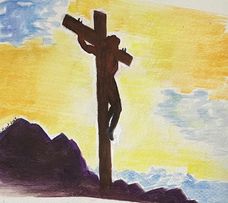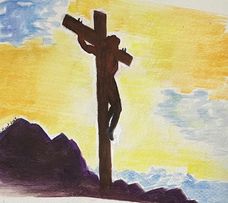What is absolutely the most vital focus of the Gospel? The essential center of the Gospel is that “Christ died for our sins according to the Scriptures, and that He was buried, and that He rose again the third day according to the Scriptures” (1 Cor. 15:3c,4).

“Crucified.” watercolor. By Kathy Hunt
About 700 B.C Isaiah prophesied the Gospel:
But He was wounded for our transgressions, He was bruised for our iniquities; the chastisement for our peace was upon Him, and by His stripes we are healed…And they made His grave with the wicked—but with the rich at His death, because He had done no violence, nor was any deceit in His mouth…He shall see the labor of His soul, and be satisfied. By His knowledge My righteous Servant shall justify many, for He shall bear their iniquities (Isaiah 53:5,9,11).
Christ’s vicarious suffering and death was for us— to pay the penalty for our sins. The agony of His passion began in prayer, where His victory over Satan was secured when He submitted His will to the Father’s.
Yet, as Josh McDowell asserts: “It is seen that Jesus was not forced to give up His life. As evidenced in Matthew 26:53,54, He had the power available to him to do whatever He pleased. It is in John 10:18 that we find the answer: “No one has taken it (My life) away from Me, but I lay it down on My own initiative. I have authority to lay it down, and I have authority to take it up again. This commandment I received from My Father.” We see that Christ willingly died for the sins of man.”1
His prolonged flogging produced His wounds by which we are healed. In 1986 the Journal of the American Medical Association (JAMA) featured an article, “On the Physical Death of Jesus Christ.” Referring to the flogging Jesus suffered, this article’s abstract stated: “The scourging produced deep stripe like lacerations and appreciable blood loss.”2 This led to hypovolemic (low blood volume) shock so Christ could not carry His own cross Himself. Crucifixion interfered with normal breathing so that death resulted from exhaustion asphyxia.
As the JAMA abstract concludes: “Jesus’ death was ensured by the thrust of a soldier’s spear into his side. Modern medical interpretation of the historical evidence indicates that Jesus was dead when taken down from the cross.”
After Jesus’ death on the cross, his body was taken down by Joseph of Arimathea, wrapped in a linen shroud and laid in a tomb. We begin this portion of scripture with Mark 15:46b:
“And he laid him in a tomb that had been cut out of the rock. And he rolled a stone against the entrance of the tomb. Mary Magdalene and Mary the mother of Joses saw where he was laid.
When the Sabbath was past, Mary Magdalene and Mary the mother of James and Salome bought spices, so that they might go anoint him. And very early on the first day of the week, when the sun had risen, they went to the tomb. And they were saying to one another, “Who will roll away the stone for us from the entrance of the tomb?” And looking up they saw that the stone had been rolled back—it was very large. And entering the tomb, they saw a young man sitting on the right side, dressed in a white robe, and they were alarmed. And He said to them, “Don’t be alarmed. You seek Jesus of Nazareth, who was crucified. He has risen; he is not here. See the place where they laid him. But go, tell his disciples and Peter that he is going before you to Galilee. There you will see him, just as he told you.” And they went out and fled from the tomb, for trembling and astonishment had seized them, and they said nothing to anyone, for they were afraid.
Now when he rose early on the first day of the week, he appeared first to Mary Magdalene, from whom he had cast out seven demons. She went and told those who had been with him, as they mourned and wept. But when they heard that he was alive and had been seen by her, they would not believe it.
After these things he appeared in another form to two of them, as they were walking into the country. And they went back and told the rest, but they did not believe them.
Afterward he appeared to the eleven themselves as they were reclining at table, and he rebuked them for their unbelief and hardness of heart, because they had not believed those who saw him after he had risen (Mark 15:46b-16:14 ESV emphasis added).
The fact is that Jesus’ dead body was never found after he was laid in the tomb. Neither the Jewish priests who accused him nor the Romans who crucified him could ever produce the one thing that would have nipped Christianity in the bud: Jesus’ dead body. Instead, when the women came to the tomb after the Sabbath, the tomb was empty except for a young man in a white robe. He spoke the first words about Jesus’ resurrection from the dead: “He has risen.” In the original Greek this word egerthe is in the aorist passive which is literally translated: “he was raised.”3 It means that he was roused from death.4 The passive voice used means that he received the action of being raised from the dead.
The second reference to Christ’s resurrection in the passage above states “he rose.” This word in Greek is anastas which means to stand up5. Jesus Himself stood up from the dead.
The third reference to Jesus’ resurrection, translated he had risen in the above passage, in the Greek is egegermenon which means “having been raised” from the dead.6
From a word-study perspective, these three words signifying Jesus Christ’s resurrection form a strong three-fold cord. To my understanding, the first action of raising Christ from the dead was performed by His Father. In the second action Christ himself stood up from the dead, which was recorded as “he rose.” The third action I believe was performed by the Holy Spirit who moved Christ to “having been raised” from the dead.
Three days after Jesus Christ died and was buried in the tomb, Jesus Christ was raised from the dead. He rose right through the collapsing burial clothes in which He had been wrapped. His resurrected body was and is seen still bearing the scars of His wounds.
Jesus Christ said, “I am the resurrection and the life. He who believes in Me, though he may die, he shall live. And whoever lives and believes in Me shall never die. Do you believe this” (John 11:25,26)?
Scriptures were quoted from the New King James Version (NKJV) unless indicated ESV: English Standard Version. NKJV capitalizes pronouns referring to God while the ESV does not.
- Josh McDowell, Evidence that Demands a Verdict, (San Bernadino, CA: Here’s Life Publishers, 1979), p. 137.
- Edwards WD, Gabel WJ, Hosmer FE. “On the physical death of Jesus Christ,” JAMA 1986 Mar 21; 255 (11):1455-63.
3. Greek-English New Testament, translated by Alfred Marshal (Washington, D.C., 1975), p. 161.
4. James Strong, Greek Dictionary of the New Testament, 1453, p. 25.
5. Strong, 450, p. 12.
6. Greek-English New Testament, p. 161.

Tom Giesecke (Sonrise Magazine Editor) Author. Grew up in Olympia, WA, where he received Christ at age 15. He graduated from Davidson College, NC, and Emory University School of Medicine, Atlanta, GA. After his medical internship at the National Naval Medical Center Bethesda, MD, he trained and served as a U.S. Navy Flight Surgeon for four years. Following residency training, he served thousands of people as a Board-certified Family Physician for more than thirty-five years. Learning of God’s love motivates Tom to daily search the Scriptures for more. Tom has led Bible studies for many years and enjoys sharing “the word of God, and recently publishing a book (find in the Sonrise Bookstore and Amazon) on the grace of God: Gracious Goodness.” Reach Tom at tomgiesecke@comcast.net

Leave a Reply